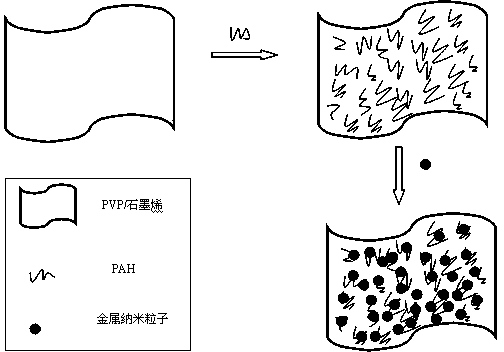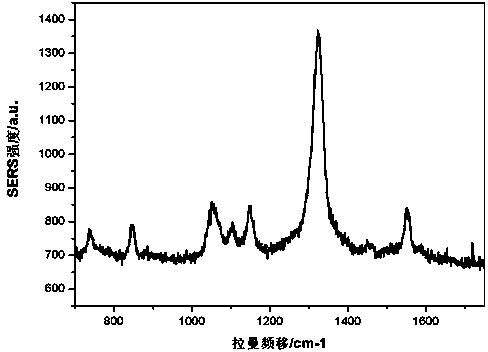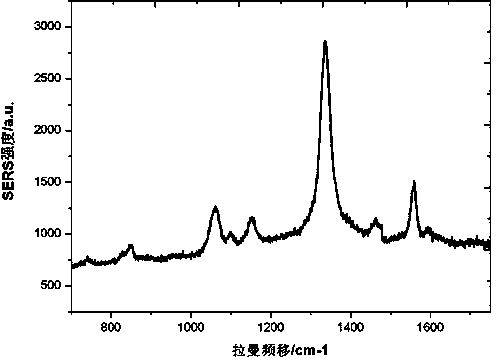Preparation method for graphene-based surface enhanced Raman scattering probe
A surface-enhanced Raman and graphene surface technology, applied in the fields of nanomaterials and bioanalytical chemistry, can solve the problems such as sensitivity, stability and biocompatibility need to be further improved, and the preparation method is cumbersome, and is environmentally friendly and repeatable. The effect of good sex and simple operation
- Summary
- Abstract
- Description
- Claims
- Application Information
AI Technical Summary
Problems solved by technology
Method used
Image
Examples
Embodiment 1
[0024] Embodiment 1 uses graphene-gold nanoparticles, graphene-silver nanoparticles, and example 2 uses the composite structure of graphene-gold nanorods as the SERS substrate, and 5,5 dithiobis(2-nitrobenzoic acid ) (DTNB) will be described as an example of a SERS marker.
[0025] Example 1
[0026] Prepare the graphene-metal nanoparticle composite structure as the SERS substrate, 5,5 dithiobis(2-nitrobenzoic acid) (DTNB) as the SERS probe, the metal nanoparticles are gold nanoparticles, gold Core silver-shell nanoparticles, the method comprises the steps of:
[0027] 1) Preparation of gold nanoparticles: Add 0.5ml of 1% tetrachloroauric acid to 50 ml of deionized water, heat to boiling under constant stirring, then add 0.5ml of 1% sodium citrate, continue stirring and heating, and keep After boiling for 15 minutes, stop heating, continue to stir, cool to room temperature, and set aside. The diameter of the obtained gold nanoparticles is about 48 nm.
[0028] Preparatio...
Embodiment 2
[0038] The composite structure of graphene-gold nanorods is used as the SERS substrate, and 5,5 dithiobis(2-nitrobenzoic acid) (DTNB) is used as the probe of the SERS marker. The method includes the following steps:
[0039] 1) Prepare polystyrene sulfonate sodium (PSS) modified gold nanorod solution and label Raman molecules. To prepare gold seeds first, mix 2.5 ml of 0.2 M cetyltrimethylammonium bromide (CTAB) solution with 1.5 ml of 1.0 mM tetrachloroauric acid solution at room temperature, stir vigorously and add 0.6 ml of ice-cold 0.01 M hydroboration Sodium solution, stop stirring after 2 minutes to obtain a brown-yellow seed solution. Then prepare the growth solution, add the following reagents in sequence in 50ml 0.2M CTAB solution at room temperature: 2~4ml 4mM silver nitrate solution, 5ml 15mM tetrachloroauric acid solution, 45ml deionized water, and stir slowly evenly. Then add 1.5ml~3ml 0.08M ascorbic acid until the solution becomes colorless. Finally, 1ml of see...
PUM
 Login to View More
Login to View More Abstract
Description
Claims
Application Information
 Login to View More
Login to View More - R&D
- Intellectual Property
- Life Sciences
- Materials
- Tech Scout
- Unparalleled Data Quality
- Higher Quality Content
- 60% Fewer Hallucinations
Browse by: Latest US Patents, China's latest patents, Technical Efficacy Thesaurus, Application Domain, Technology Topic, Popular Technical Reports.
© 2025 PatSnap. All rights reserved.Legal|Privacy policy|Modern Slavery Act Transparency Statement|Sitemap|About US| Contact US: help@patsnap.com



